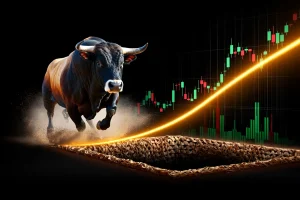
What Is a Trade War? A Recipe for Inflation and Global Backfire
Introduction: Everyone Loses and No One Learns
June 3, 2025
A tariff war is an economic conflict where countries impose tariffs (taxes on imported goods) on each other’s exports, often in a retaliatory cycle. These tariffs aim to protect domestic industries, gain leverage in trade disputes, or discourage trade. While they may offer short-term benefits, tariff wars can disrupt economies, escalate tensions, and lead to long-term costs, such as recessions and supply chain disruptions.
This isn’t just policy gone rogue—it’s coordinated chaos dressed up as negotiation. The market knew tariffs would sting, but it didn’t expect a full-on global barrage. No region spared. No asset class is immune. And just when markets start adapting, a sudden “reprieve” is dangled—then yanked like a carrot from a starving mule. Case in point: the ever-slippery deal with China. One day it’s peace. The next tariffs on soybeans, tech, whatever’s convenient.
There’s no value in playing moral referee here. Right and wrong are illusions—tools used to soothe one side while justifying the destruction of the other. What’s righteous in one hemisphere is heresy in another. This is not about ethics. It’s about currency—fiat, flowing, ever-expanding. The more they print, the more madness unfolds. Wars become business models. Trade becomes warfare. Sanity is traded for speculation.
Zoom out. Strip away the emotion. What’s left? A brutal, clear picture: nothing is off the table when the only objective is to extract more. The pursuit of profit has gone primal. Governments, corporations, and even citizens are pushing past old limits. And it’s not just the U.S.—the entire world is clawing, competing, and collapsing moral boundaries for the sake of gain.
What Are Tariff Wars?
Tariff wars begin when one country imposes tariffs on imports from another, often to pressure that country to change its trade practices. The targeted country then retaliates by imposing its own tariffs on imports from the initiator, triggering a retaliatory cycle that escalates with each move. What starts as strategy becomes stubbornness. What was a negotiation turns into economic trench warfare.
1. What are Tariffs?
Tariffs are taxes levied on imported goods, which increase their price and make foreign products less competitive. Governments justify them as a way to protect domestic industries, enforce trade rules, or serve national security interests. But like any blunt instrument, they create collateral damage.
2. What Happens in a Tariff War?
A cycle of tariffs triggers counter-tariffs, often widening in scope. What started as a single policy move balloons into hundreds of products across key industries. Agriculture, tech, energy—no sector is safe. Consumers and businesses pay the price as each government tries to out-bluff the other, forgetting the end goal.
3. Examples of Tariff Wars:
- The U.S.-China Trade War (2018–present): Initiated to curb Chinese trade practices, it led to tit-for-tat tariffs that disrupted global supply chains, stunted growth, and spooked markets.
- The Smoot-Hawley Tariff Act (1930): Meant to protect American jobs during the Great Depression, it invited retaliation from trading partners and worsened the global economic collapse.
4. Impacts of Tariff Wars:
Economic Disruptions:
Tariffs increase costs for raw materials, intermediate goods, and finished products. Domestic producers pay more for inputs, businesses pass costs to consumers, and demand contracts. Inflation creeps in—not from too much money, but from artificially constrained trade flows. Small businesses suffer. Big corporations relocate.
Supply Chain Disruptions:
Trade wars fracture the fragile web of global supply chains. Components once sourced from halfway around the world become liabilities. Manufacturing slows. Delivery times stretch. Margins shrink. In worst-case scenarios, production halts. Firms scramble to reroute logistics while absorbing higher costs.
Escalating Tensions:
Tariff wars rarely stay confined to economics. They spill into diplomacy, poisoning relations between allies and rivals alike. Trust erodes. Cooperation dies. Trade talks stall. Meanwhile, geopolitical conflicts intensify because economic pressure breeds resentment rather than compromise.
Potential for Recessions:
A full-blown trade war can choke off growth. Investment dries up under the weight of uncertainty. Multinational deals collapse—stock markets reel. Tariff wars serve as accelerants to existing vulnerabilities, fueling a downturn that might have otherwise been a slowdown.
Inflation & Reduced Consumer Choice:
Consumers pay more for less. Tariffs mean higher prices, limited imports, and lower-quality substitutes. Inflation isn’t just monetary—it’s policy-driven. When choice is stripped, innovation suffers, and pricing power shifts back to entrenched incumbents. That’s anti-competitive by design.
Innovation Slowdown:
With rising operating costs, companies—especially in the ICT and manufacturing sectors—cut R&D budgets. Startups struggle to scale. Tech stagnates. Trade wars aren’t just wars on trade—they’re wars on the future.
Industry-Specific Damage:
Agriculture, auto, steel, semiconductors—these sectors often take the brunt. Entire supply chains implode under the pressure of retaliatory tariffs. Farmers lose export markets. Auto parts cost more. Manufacturers delay capital investments.
Environmental Consequences:
Trade wars can divert production to countries with looser environmental regulations, worsening global emissions and resource depletion. Efficiency drops. Pollution spikes. Carbon becomes a casualty of nationalistic policy.
5. Short-term vs. Long-term Impacts:
Short-Term Sugar High:
Governments often tout quick wins—protecting a factory here, forcing a concession there. But these are surface-level victories. Local industries may feel relief, but it’s short-lived. Prices rise, alternatives shrink, and retaliation kicks in. Meanwhile, investor confidence evaporates.
Long-Term Blowback:
Over time, the artificial barriers created by tariffs backfire. Industries grow lazy under protectionism. Global supply networks fracture, and once-stable trading partners become economic enemies. Innovation stagnates. Strategic alliances erode. Inflation sticks. Volatility becomes embedded. And unlike physical wars, there’s no peace treaty—just a drawn-out erosion of economic efficiency.
Reduced Investment & Volatility Spike:
Tariff wars don’t just affect the price of soybeans or iPhones—they undermine entire capital allocation frameworks. Why invest in new plants or innovation when policy could wipe out your market next quarter? That hesitation becomes contagious. Public markets feel it first—wild swings, sharp revaluations, and risk-off rotations. But the deeper damage happens under the surface.
Cultural & Diplomatic Damage:
Trade isn’t just about money. It’s a conduit for cultural exchange, diplomatic trust, and soft power. Trade wars kill that. Collaboration gives way to confrontation. And as walls go up, mutual understanding collapses.
Zero-Sum Thinking Takes Hold:
At the heart of all trade wars is a flawed assumption: that economic gain is zero-sum. That your win is my loss. But global markets are ecosystems, not battlefields. When one node collapses, the whole network weakens.
Tariff Wars, Volatility, and the Ugly Truth No One Wants to Face
Uncertainty is no longer the side effect—it’s the product. Tariffs aren’t about economic growth anymore. They’re tools of destabilization. And where chaos becomes policy, only tactical players survive. This isn’t the season for blind conviction. It’s a scalpel market—precise, deliberate moves. Position trading is the weapon. Longer-dated options? Insurance, not prediction.
You’ve seen the shift—we’ve leaned harder into stock plays. That’s not accidental. Options are leverage and leash. You pull them wrong, and you get dragged. But done right, even the leash becomes a blade.
Technically? SPX should’ve cracked weeks ago. It didn’t. So now it teeters. 5700 holds—barely. Below that? A landslide. Below 5600? A trigger. But if it rips instead? Blow-off top. Watch 6250. If we get there, the comedown will be brutal.
So stay tactical. Stay adaptable. Let the tourists chase headlines. We track energy. We strike when illusion breaks.
Trade wars might dominate the headlines. But what matters is how you play the tape behind the noise.
This is economic warfare—and most don’t even know they’re in it.












